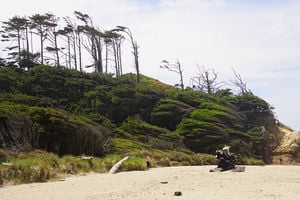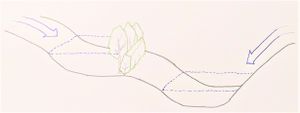Windbreaks (also termed shelterbelts) are barriers to intercept wind and create a relatively sheltered area.
Article Scope
This article discusses considerations in windbreak design. The main focus is windbreaks to create a favorable microclimate for a temperate climate forest garden. This situation is one of the main reasons windbreaks are relevant to sustainable agriculture in the West, particularly in view of climate change. However windbreaks have a wider relevance in industrial agriculture settings such as agroforestry and animal husbandry, and the technique can be easily applied to other climates.
Terminology & Background
- Wind is the movement of atmospheric gases on a large scale. Generally air moves from an area of high atmospheric pressure to an area of low pressure. Differences in air pressure are caused by air rising creating low pressure or air sinking causing high pressure.[1]
- Upwind (Windward) refers to the direction the wind is blowing from.
- Downwind (Leeward) refers to the direction the wind is blowing to.
- Winds are usually named according to their direction of origin. For example wind blowing from east to west is termed "Easterly".
- Prevailing wind is the direction which wind tends to originate over a period of time for a particular location (e.g. the mean annual wind direction).
Prevailing Wind: Global Influences
Global wind patterns are created by 2 main factors: 1. the uneven heating of the surface of the Earth (Tropical regions are heated more than polar regions, caused by the curvature of the Earth), and 2. the rotation of the Earth. Air at the equator is heated, becoming less dense. Air would tend to rise in the equator and move towards the poles, then cooling, becoming more dense and sinking again and moving back towards the equator. This convection system is termed a cell. However, due to uneven distribution of land and ocean and the rotation of the earth, there exist 3 such cells per hemisphere (Polar, Ferrel and Hadley cells). The polar and Hadley cells are temperature driven cells, whereas the Ferrel or mid-latitude cell is caused by an interaction of the polar and tropical cells. The earth's surface moves faster at the equator than near the poles (the axis of rotation). Therefore as air moves away from the equator it is also under the influence of the Earth's anticlockwise rotation, so it does not move in a straight line but in a curved direction to the right in the northern hemisphere and to the left in the southern hemisphere. This is termed the Coriolis effect, and gives rise to the "westerlies" and the "trade winds". Air rising and falling within these cells also hugely influence the climates of the world by the creation of semi-permanent areas of high and low pressure at particular latitudes, dictating the degree of precipitation and therefore the distribution of deserts and rainforests.
Take the example of the British Isles, which are within the northern hemisphere's Ferrel cell. The suface wind would be southerly, but due to the Coriolis effect, typical prevailing winds are from the south-westerly or westerly.[2]
Prevailing Wind: Local Influences
There is a variation in mean annual wind direction on a regional level, due to large scale topography such as coasts and mountainous regions. The simplest example is the sea breeze. The sea/ocean takes longer to warm compared to land. This leads to a difference in how much the surface air temperature between sea and land. As the air over the land is heated, it becomes less dense and rises, creating low pressure. The surface air over the sea is relativley cooler and denser, and there is movement of air from the high pressure area to the low pressure area.
Another example is the Foehn effect. Air approaching an elevated area is forced upwards, where is cools and becomes less dense due to lower atmospheric pressure at higher altitutes. Smaller scale topography is also very important on local wind conditions.
Again taking the example of the British Isles, high ground over Wales, northern England and Scotland leads to Smaller topographical features have an even greater effect on prevailing wind. However, the prevailing wind is also greatly influenced by seasonal variation. North-easterly winds are as common than southwesterly winds in spring (in some years considerably more common).[3]
Influence of wind on plants

Generally speaking, gentle wind is beneficial for plants, but as wind speed increases this quickly can cause detrimental changes. Some plants use wind to disperse pollon or seed. Movement of air increases the rate of gas exchange via the stomata of leaves by supplying fresh carbon dioxide for photosynthesis and oxygen for respiration. Wind also tends to cool plants down, and this can be beneficial assuming there is enough water to prevent dessication.[1] Completely stagnant air is known to promote many plant diseases.[1] However if wind speed is too high, shoots and stems may be broken (e.g. see "lodging"W), and extreme wind speeds uproot trees or seriously damage their root systems (see "windthrow"W).[1] Woody plants exposed to too much wind can get wind scorched, which is dessication of leaves and shoots caused by water loss under strong wind and high temperature conditions. In colder areas, if the water in the soil is frozen the plant cannot replace water losses in high wind conditions, and similar damage may occurs.[1] Activities of beneficial insects (e.g. pollinators or predators of pest species) tend to be suppressed in windy conditions. Chronic exposure to strong winds causes unbalanced growth (see "Krumholz"W). Soil erosion may also result from chronic windy exposure, which fundamentally alters the resulting ecosystem.
Types
Windbreaks may be considered according to their purpose as either Field windbreaks (for crops), Livestock windbreaks and living snowfences (stop snow drifts).[4]
Windbreaks around a house can exist in the form of hedges, gabions (filled with stones or plant leaves), wattle fences or walls (stone, soil, etc).
Advantages
- Reduce wind blown soil erosion
- Increase crop yields
- Keep snow drifts out of feed lots
Livestock:
- Shelter animals from hot summer wind or cold winter wind
- Reduce animal stress
- Reduce animal mortality, particularly young (e.g. calves)
- Reduce animal feed requirements (animals will burn more calories if they are in colder conditions)
- Reduce dust
- Reduce noise
- Provide habitat for wildlife. Windbreaks may offer travel corridor for wildlife.
- Buildings in windy areas can reduce heating costs up to 30% by placement of a sheltering windbreak.[2]
- Windbreaks can reduce gaseous ammonia by approximately 50% downwind of poultry farms.[5] Up to a threshold, plants also benefit from aborbing ammonia as a source of nitrogen, improving growth. Over the threshold, too much ammonia causes plant tissue necrosis, reduced growth and increased sensitivity to frost damage.[6]
Windbreaks reduce plant transpiration by reducing windspeed. [3] Windbreaks reduce crop water stress by reducing soil water loss. [3]
Design considerations
In agroforestry science, 7 structural elements are said to influence windbreak effectiveness, namely: Height, density, orientation, length, width, continuity/uniformity and cross-sectional shape. There are a few other issues to dconsider such as frost pockets and rain shadow.
Height
The height (H) is hugely important in the size of the area of protection. Wind speed is reduced for an area upwind equivalent to 2-5 times the windbreak height (2-5H), for an area downwind equivalent to up to 30H.[7]
Density
Orientation
Length
Width
Continuity/uniformity
Cross-sectional shape
Frost Pockets

Plants vary in their response to frost. Frost reduces availability of soil moisture for plant roots to replace water loss by transpiration.[1] Generally speaking deeper rooted plants are less vulnerable to frost damage compared to shallow rooted plants, because deeper roots extend below the frost line.[1] Sometimes newly planted or shallow rooted plants can be lifted up slightly by expansion of water in soil as it freezes.[1] Cell sap expands when frozen and may cause plant cell walls to be destroyed.[1] Repeated freezing and rapid thawing can be particularly damaging to roots.[1] New, spring growth is vulnerable to late frosts,[1] e.g. by damaing blossom of fruit trees such as peach, preventing successful pollination,[4] and therefore decreasing yield. Tree bark can be split open by freezing and thawing on the equator facing side of the trunk (see frost crackW). Black frost (also termed "killing frost") refers to the necrosis of plants due to frost damage.
Sometimes what appear to be more sheletered sites can be at higher risk of hard frosts.[4] As air temperature drops during night or cold weather, it becomes less dense and therefore sinks. Cold air will therefore tend to flow down slopes and accumulate in the lowerest point, e.g. the bottom of a valley or a hollow. Barriers such as banks, hedges, walls and fences will influence the movement of cold air. To visualize how cold air behaves, imagine pouring thick fluid over the landscape. If a barrier exists which prevents the cold air from flowing away, a frost pocket is formed.[4] In frost pockets, frost will be more severe and persist for longer in the day.[5]
Therefore it is potentially advantageous to design gaps in the windbreak to allow cold air to flow out of an area. Barriers can also be positioned to intercept cold air and divert it away from a location. To achieve this, the windbreak could be sited slightly off contour.[5] A small gap can also be left in the windbreak to allow cold air to flow away, but this should not create a wind tunnel effect,[5] e.g. by facing away from the prevailing wind direction. Another option is to thin the trees to allow the cold air to flow through,[1] although reducing the effectiveness of the windbreak.
Rain shadow
The rain shadow effect is where there is less rainfall immediately downwind of a barrier such as a windbreak (relative to prevailing wind direction).[1] This effect is far more pronounced with impermeable windbreaks, and the area of relative dryness is also proportional to the height of the windbreak.
References
Further reading
- The University of Missouri Center for Agroforestry. http://www.centerforagroforestry.org/practices/wb.php
http://www.centerforagroforestry.org/pubs/training/chap6_2015.pdf
- Agroforestry Practices - Windbreaks (2004) - University of Missouri Center for Agroforestry (Available to view on YouTube)
See also
- ↑ 1.00 1.01 1.02 1.03 1.04 1.05 1.06 1.07 1.08 1.09 1.10 1.11 Encyclopedia of Gardening. Royal Horticultural Society. Dorling Kindersley, 2002
- ↑ [https://www.agroforestry.co.uk/about-agroforestry/other-agroforestry-systems/%7CAgroforestry Research Trust}
- ↑ 3.0 3.1 C Adams; M Early; J Brook; K Bamford (2015). Principles of Horticulture: Level 3. Routledge. ISBN 9781317937807.
- ↑ 4.0 4.1 4.2 The Fruit Tree Handbook. B Pike. Green Books, 2011
- ↑ 5.0 5.1 5.2 Creating a Forest Garden: working with nature to grow edible crops. M Crawford. Green Books, 2016